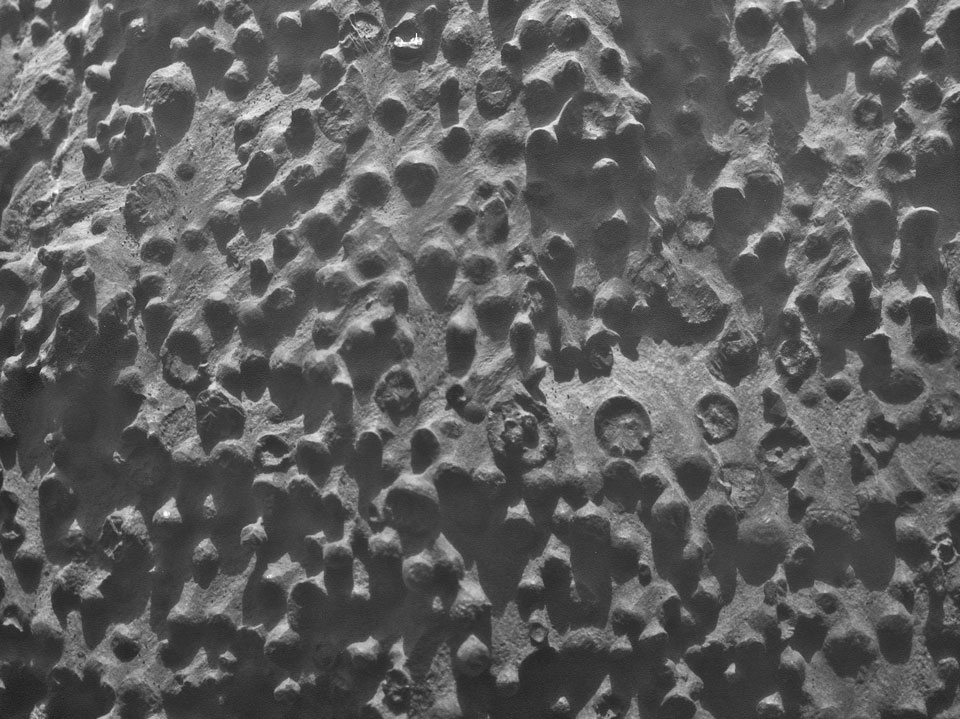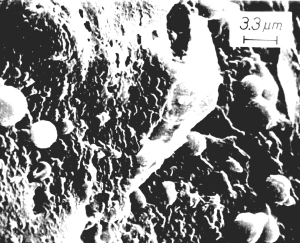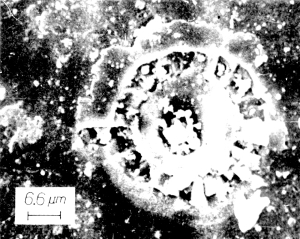It looks like you're using an Ad Blocker.
Please white-list or disable AboveTopSecret.com in your ad-blocking tool.
Thank you.
Some features of ATS will be disabled while you continue to use an ad-blocker.
share:
The Soviet Union's "Luna 16" and "Luna 20" spacecrafts has found Microorganisms into Moon regolith in 1970! I never known about this. Do you?

www.panspermia.org...# 1ref
Oh my god....

www.panspermia.org...# 1ref
On 24 September 1970 , for the first time, an unmanned spacecraft delivered a lunar "soil" sample to Earth. The Soviet Union's Luna 16 spacecraft returned from the moon's Sea of Fertility with 101 grams of lunar regolith in a hermetically sealed container (1). In February 1972, only 120 kilometers from the Luna 16 site, Luna 20 used a drill with a ten-inch, hollow-core bit to collect another regolith sample that was also hermetically sealed on the moon (2).
Luna 20: Fossils similar to modern coccoidal bacteria Siderococcus or Sulfolobus, lithified by metalic iron. (Upper scalebar = 1.2 micrometers).
[...] Further study of the photographs was later undertaken by two biologists at the Russian Academy of Sciences, Stanislav I. Zhmur, Institute of the Lithosphere of Marginal Seas, and Lyudmila M. Gerasimenko, Institute of Biology. They noticed that a few of the particles in the photographs were virtually identical to fossils of known biological species. Specifically, some spherical particles from the Luna 20 regolith plainly resemble fossils of modern coccoidal bacteria like Siderococcus or Sulfolobus in their scale, distribution, form, and the distortion of the spheres that occurs during fossilization.
Luna 16: A silicated fossil found in lunar regolith similar to modern spiral filamentous microorganisms such as Phormidium frigidum. Lunar microfossil resembling a spiral filamentous microorganism, from O.D. Rode et al., D. Reidel Publishing Co., 1979.
[...] the fossil's unmistakable resemblance to modern spiral filamentous microorganisms like Phormidium frigidum
Their new analysis of these particles was announced at an astrobiology conference in Denver, 20-22 July 1999, and published in the conference proceedings in December 1999 (4).
[...]The microfossils from the moon are different. Each Luna sample was encapsulated on the moon and opened only in a laboratory where examination commenced immediately. These fossils are solid evidence for ancient life elsewhere in space.
Oh my god....
edit on 8-11-2012 by Arken because: (no reason given)
Although i hope its true......i remain on the fence over this one.
It would be the cats meow if this is truth.
It would be the cats meow if this is truth.
even if this were true scientist will never allow this to be revealed they would lose their jobs for lying
If the moon is nothing more than chunks of earth possibly from a meteor millions of years ago crashing into earth and spewing up debris than maybe our
little friends are nothing more than Terran life forms perfectly preserved in the vacuum of space......good as a deep freeze.
reply to post by Arken
Looks like what the Rover found on Mars.
Though the Martian spheres seems bigger.
I wonder if it is connected in any way.

Looks like what the Rover found on Mars.
Though the Martian spheres seems bigger.
These particular berries, measuring as much as one-eighth of an inch (3 millimeters) in diameter, cover an outcrop called Kirkwood in the Cape York segment of Endeavour Crater's western rim.
I wonder if it is connected in any way.

edit on 8-11-2012 by LiberalSceptic because: (no reason given)
edit on 8-11-2012 by LiberalSceptic
because: (no reason given)
Didn't they realise that these organism came from earth? I think they did.
I'm pretty sure this has been covered. Turns out the organism took a ride from earth.
I'm pretty sure this has been covered. Turns out the organism took a ride from earth.
You would think that there would be some sort of follow-up to this story during the last twelve years, even if there is nothing to it.
the very first place life grows. is in Asteroids.
when a star goes super nova, it makes heaver elements.
and the fly off at high speed. and make Asteroids.
they fly around space for a very long time. longer than the life of a planet.
their are far more Asteroids than stars and planets.
they get heated up ever so often.
and this makes the chemicals react with each other.
in the Asteroids life slowly grows.
and if it gets lucky, it will crash onto a planet that it can grow on.
when a star goes super nova, it makes heaver elements.
and the fly off at high speed. and make Asteroids.
they fly around space for a very long time. longer than the life of a planet.
their are far more Asteroids than stars and planets.
they get heated up ever so often.
and this makes the chemicals react with each other.
in the Asteroids life slowly grows.
and if it gets lucky, it will crash onto a planet that it can grow on.
reply to post by pacifier2012
What was your exact point upon replying in this thread if you honestly had nothing to add to the topic and obviously did not enjoy reading it? Just move on with your life, we don't need your unimpressed dialogue here.
Anyway, I kind of like the theory above. That these were just lifeforms on Earth at the time of the strike that after being shipped out into the vacuum of space became... Freeze dried for a better term and this is what's left. It would be quite interesting to actually explore the moon further for more things like this. If this were true, it could give us a whole lot more information about the history of our planet.
What was your exact point upon replying in this thread if you honestly had nothing to add to the topic and obviously did not enjoy reading it? Just move on with your life, we don't need your unimpressed dialogue here.
Anyway, I kind of like the theory above. That these were just lifeforms on Earth at the time of the strike that after being shipped out into the vacuum of space became... Freeze dried for a better term and this is what's left. It would be quite interesting to actually explore the moon further for more things like this. If this were true, it could give us a whole lot more information about the history of our planet.
I think its common knowledge that life forms can hitch rides on cosmic bodies that have interactions with the earth.
Its either HOAX or old news.
Its either HOAX or old news.
reply to post by Myomistress
I agree, with the whole of space at just above absolute zero its the perfect place to explore the truth behind the life on earth.
It could provide some valuable insight in to the evolution of life on earth.....The Truth Is Out There.
I agree, with the whole of space at just above absolute zero its the perfect place to explore the truth behind the life on earth.
It could provide some valuable insight in to the evolution of life on earth.....The Truth Is Out There.
Honestly I think there is life of some sort on every single planet/star. We don't know # yet on what can or can't survive and where. We have found
many things where we thought life was not possible here on Earth.
reply to post by HawkeyeNation
I agree, we don't know anything yet. In this infinite universe, holds infinite possibilities.
I agree, we don't know anything yet. In this infinite universe, holds infinite possibilities.
Here you go Arken, they talk about the Lunar samples in this article written in 2010, which talks about the origin of life. Lots of good reading in
here. The article is proposing that life was transplanted here of course.
Journal of Cosmology
Journal of Cosmology
Good read for sure
However, I recall something at least similar to this being brought up before. The end conclusion was scientists claiming the organisms to have originated here on Earth and somehow got mixed into the samples during the trip
Either way, I am confident that life exists elsewhere in our universe. We may as a species, simply not yet have the technology and expansive research to prove it.
However, I recall something at least similar to this being brought up before. The end conclusion was scientists claiming the organisms to have originated here on Earth and somehow got mixed into the samples during the trip
Either way, I am confident that life exists elsewhere in our universe. We may as a species, simply not yet have the technology and expansive research to prove it.
Just maybe, when the earth was hit by [insert best guess here] and caused the extinction of the dinosaurs, debris was launched into space and became
part of the lunar surface?
just a thought.
just a thought.
Originally posted by forall2see
Good read for sure
However, I recall something at least similar to this being brought up before. The end conclusion was scientists claiming the organisms to have originated here on Earth and somehow got mixed into the samples during the trip
Either way, I am confident that life exists elsewhere in our universe. We may as a species, simply not yet have the technology and expansive research to prove it.
Actually the article I linked to talks about that.
One of the dissenting opinions on that is, a piece of equipment brought back from the moon by the Apollo astronauts from our lunar surveyer that had spent 8 years on the moon had a single cell of a bacteria on it.
The idea was that it came from a "dirty" work bench originally here on the Earth. The funny thing about that is, this bacteria would have 750 million cells of it in a single drop of saliva, so finding only one on the equipment was strange in itself.
Being a skeptic, at the same time, I'm very open that life here on Earth may have been from somewhere else (Mars, an asteroid, etc, etc). Many arguments for it make a lot more sense to me than: it just happened. heh.
I think another good argument for it is what we see everyday here on our planet: life is tenacious! Just TRY and keep things from spreading. I battle life every spring and summer out in my yard and garden! Plants, bugs, you name it.
One kid goes to school sick, and 100 are home the next day sick with the same thing.
I brew my own beer at home, and making sure my equipment is sterile when I begin is important, but sometimes, no mater how careful I am, I get a "skunked" batch once in a while (wild yeast or bacteria got into it).
We've seen life go dormant when conditions are not good for it or hostile for it, only to see it come alive when conditions are made right again.
So for me, I think the idea that microfossiles can be found on the moon is not far fetched at all. I don't think it's because it started there however, nor thrived there, but was simply transplanted from somewhere else too.
You guys may find this interesting, but probably know about them already. I just learned about them last night.
Source
Images
What is interesting about them is they are more complex than bacteria and they survive in space.
Tardigrades, or "water bears," are microscopic eight-legged critters known to survive extreme temperatures, tons of radiation, and nearly a decade without water on Earth.
Source
Images
What is interesting about them is they are more complex than bacteria and they survive in space.
new topics
-
A Warning to America: 25 Ways the US is Being Destroyed
New World Order: 4 hours ago -
President BIDEN's FBI Raided Donald Trump's Florida Home for OBAMA-NORTH KOREA Documents.
Political Conspiracies: 10 hours ago -
Maestro Benedetto
Literature: 11 hours ago -
Is AI Better Than the Hollywood Elite?
Movies: 11 hours ago
top topics
-
President BIDEN's FBI Raided Donald Trump's Florida Home for OBAMA-NORTH KOREA Documents.
Political Conspiracies: 10 hours ago, 28 flags -
Gaza Terrorists Attack US Humanitarian Pier During Construction
Middle East Issues: 16 hours ago, 8 flags -
A Warning to America: 25 Ways the US is Being Destroyed
New World Order: 4 hours ago, 8 flags -
Las Vegas UFO Spotting Teen Traumatized by Demon Creature in Backyard
Aliens and UFOs: 15 hours ago, 6 flags -
2024 Pigeon Forge Rod Run - On the Strip (Video made for you)
Automotive Discussion: 15 hours ago, 4 flags -
Is AI Better Than the Hollywood Elite?
Movies: 11 hours ago, 3 flags -
The functionality of boldening and italics is clunky and no post char limit warning?
ATS Freshman's Forum: 17 hours ago, 1 flags -
Maestro Benedetto
Literature: 11 hours ago, 1 flags
active topics
-
President BIDEN's FBI Raided Donald Trump's Florida Home for OBAMA-NORTH KOREA Documents.
Political Conspiracies • 20 • : theatreboy -
A Warning to America: 25 Ways the US is Being Destroyed
New World Order • 6 • : theatreboy -
Supreme Court to decide if states can control fate of social media
Education and Media • 14 • : SMMPanelPro -
Gaza Terrorists Attack US Humanitarian Pier During Construction
Middle East Issues • 35 • : Lazy88 -
Definitive 9.11 Pentagon EVIDENCE.
9/11 Conspiracies • 426 • : Lazy88 -
Alternate Electors vs Fake Electors - What is the Difference.
2024 Elections • 117 • : ADVISOR -
-@TH3WH17ERABB17- -Q- ---TIME TO SHOW THE WORLD--- -Part- --44--
Dissecting Disinformation • 691 • : Imbackbaby -
Victoria government has cancelled the commmonwealth games, no money.
Regional Politics • 3 • : nazaretalazareta -
When an Angel gets his or her wings
Religion, Faith, And Theology • 22 • : AcrobaticDreams1 -
King Charles 111 Diagnosed with Cancer
Mainstream News • 321 • : FlyersFan



